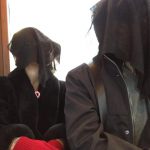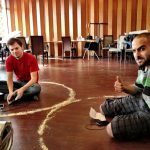How much can I get into one suitcase? Do I need a sleeping bag? And what does one wear to a Nordic LARP anyway? These were all questions that ran through my mind when I packed in preparation for my first jaunt overseas in a long while. I was going to attend Knutepunkt, the Nordic LARP conference held once a year in one of the four countries that make up the heart of the Nordic scene – Denmark, Sweden, Finland and Norway. I’d be spending four days in Oslo for the Week in Norway program and then would head up to the main conference up in Haraldvangen, a camp grounds on a beautiful lake. Looking back now back in Brooklyn, I realize I was in no way prepared for how much this trip would have such a profound change on my life.
This is Part 1 of my analysis of the whole Nordic LARP adventure. There’s so much to talk about I’m splitting it up. Pictures included are credited to their creators.
To Begin – What is Nordic LARP?
That question is a little harder to explain than one would imagine. People have been debating the actual definition for the movement for ages, so I don’t presume to have a good one just yet (if I ever will). For better and more concise explanations, I refer to Lizzie Stark’s blog. Or even better, check out Jaakko Stenros’s wonderful lecture in the Nordic LARP Talk series. But here we go anyway, let’s give it a shot, with a little context to the overall LARP community included too.
To those who are familiar with live action role-play games, or LARPs, a simple introduction would start by saying that there are lots of different traditions in the LARP community. Within the United States and abroad, the major traditions include:
- Theater-style games: these are usually categorized as games that involve non-physical combat styles and simulation of events through description and symbolic representation. Famous theater-style LARP systems include the Mind’s Eye Theater system by White Wolf for it’s World of Darkness setting. It’s meant to be (mostly) no physical contact.
- Boffer games: This is a broad term for games that involve actual physical contact in their combat systems. Players use latex or foam weapons to engage in simulated combat, while magic and other supernatural events are symbolically represented using things like ‘spell packets’ (tiny bean bags or birdseed filled sewn packets) or light sources. These games tend to aim for more physical immersion in environment design to help drag the players into a What You See Is What You Get atmosphere.
While these are two of the predominant systems of gameplay in LARP, each full of their own traditions and development history, there is a third tradition that has been gaining more international attention in the last few years. That tradition is known as Nordic LARP and though as the name suggests it began in the Nordic countries, its influence has been felt across Europe and in recent years in the US, Canada and South America.
So what is Nordic LARP? It’s a tradition of LARP heavily influenced by artistic and theatrical expression that focus on high immersion both in environment and emotional/psychological engagement. The games in this tradition tend to focus on serious material and frame their games with workshops before the game and debriefs afterwards to present a well-informed and emotionally safe environment to engage in serious subject matter. The games also utilize what are known as metatechniques within the game to structure the play, drawing heavily from theatrical and cinematic influences. The culture also involves putting aside stricter goal-driven, ‘winning’ mindsets by encouraging players to often ‘play to lose’ so as to experience a richer story in game, as well as encourages players to create characters that let them play close to home and tie themselves emotionally to their characters. This can cause a lot of bleed, emotional cross-over from your character to yourself, which is something that Nordic LARP encourages for richness of play.

What develops out of these and other complexities of the Nordic tradition is a body of games that are deeply touching, well-structured, and immersive to players. The Nordic community is also heavily interested in cultivating a body of work which documents LARPs, since by nature larps are ephemeral and cannot be repeated exactly. For that reason, one can read up on some of the major games over there, like Mad About the Boy (based on Y: the Last Man), Kapo (a prison-camp LARP about internment and the loss of humanity during incarceration), and Just A Little Lovin’ (about the AIDS crisis in the 80’s in NYC). There’s also an amazing textbook on the community called Nordic LARP by Jaako Stenros and Markus Montola which has received critical acclaim, including winning the Diana Jones Award at Gencon in 2012.
Knutepunkt developed as the convention center of this developing community, a conference where games could be showcased and discourse on the art of making larps could be held. As far as I can tell, Knutepunkt is THE place to discuss Nordic LARP and welcomes passionate designers and players from everywhere once a year. This was my first time in attendance.
The Trip Over and A Week in Norway
I caught a flight overnight and arrived in Norway Monday morning. I was traveling with Chris, a DC area gamer and larp organizer that I met earlier this year at InterCon. We stayed together at a local hotel in Oslo while participating in A Week in Norway, the four day extended programming provided by the Knutepunkt organizers for those who wanted to cram more Nordic LARP experience into their trip. From Monday on they had a community house open with games and food available all day, and events planned for the participants. We did a workshop on rituals in LARP, a particular favorite tradition of the Norwegian designers, that took place inside a mausoleum. We listened to talks about Nordic LARP hosted by Nordic Larp Talks, including presentations by Jaako Stenros (co-author of Pervasive Games and the Nordic LARP book), Annika Waern (Pervasive Game co-author) and Sarah Lynne Bowman (author of The Functions of Role-Playing Games). And one of my personal favorites, we played a game called Limbo, held on a tram as it rode around the city and experienced being trapped in Purgatory.
Part of the events scheduled also included larps written by participants in the Larp Exchange Academy, an extension of the summer LARP Exchange Academy run in Vilnus, Lithuania in June. These brave souls traveled from their home countries to be holed up in a house in the hills outside of Oslo to spend three days writing LARPs. The results were some brand new games which we play tested during that week we were there. I had the pleasure of playing a game called Stereo Hearts, in which the players explored inter-personal relationships using songs on your playlist and recited monologues. I was at first skeptical – I’d seen game jams done but a game jam on larps? And a game about playlists to share emotion?
I was never so happy to be wrong. Stereo Hearts proved to be a moving, extremely engaging game with some fantastic use of Nordic metatechniques. I don’t think I’d ever engaged so quickly or so deeply in emotional relationships in a LARP. Afterwards, I felt emotionally exhausted and yet happy, as I’d been deeply touched by the depth of internal struggles we’d experienced in a brief game.
That is a great way to describe most of my week in Oslo – emotionally exhausted and yet happy. I had never imagined that immersing myself in the Nordic LARP scene would require me to open up quite so much of myself, both in games and in inter-personal relationships. I spent a lot of the time meeting new people and discussing the differences between LARP cultures in different countries, and as a result met a lot of wonderful, friendly, intelligent folks from more countries than I could name. Personally, the games that I was introduced to also required me to dig deep into my own emotions to feed the role-play and I soon found myself exploring some deep-down emotionally intense places both during and after events.
I soon realized why the Nordic larp tradition focuses intently on what is known as debriefing or after-care, in which organizers go over the events of the game and how players felt about what went down. While this might sound very touchy-feely to gamers from America, this culture of after-care is instrumental in giving players an avenue to express what they felt in a game should they feel the need. I found myself being open and honest about how events in character felt and what I was thinking about after the game ended, a space that I often find lacking in American LARPs. I also found myself talking extensively with other designers and larp academics about the emotional implications of the idea of ‘bleeding’ in and out of ones character, whether that was ‘healthy’ and whether or not after-care was needed – all fodder for a blog post all it’s own shortly.
Overall, the week in Norway provided me with insight into how the community worked and gave me a great taste of what’s to come. Because if I believed that four days in Oslo with Nordic LARP was intense, I was nowhere prepared for the awesomeness of Knutepunkt 2013.
To be continued…





